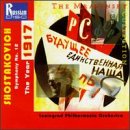| All Artists: Mravinsky, Glinka, Shostakovich, Leningrad Phil Title: The Mravinsky Collection- Shostakovich: Symphony No. 12 in D minor, Op. 112 (The Year 1917- in Memory of Lenin) / Glinka: Overture to Ruslan and Ludmila Members Wishing: 0 Total Copies: 0 Label: Russian Disc Release Date: 9/1/1996 Genre: Classical Styles: Historical Periods, Modern, 20th, & 21st Century, Symphonies Number of Discs: 1 SwapaCD Credits: 1 UPC: 748871091221 |
Search - Mravinsky, Glinka, Shostakovich :: The Mravinsky Collection- Shostakovich: Symphony No. 12 in D minor, Op. 112 (The Year 1917- in Memory of Lenin) / Glinka: Overture to Ruslan and Ludmila
CD Details |
CD ReviewsSome notes on this work Slobberer | Astoria, NY United States | 05/15/2004 (5 out of 5 stars) "There are five Shostakovich Symphonies of his fifteen that have political/historical programs: Nos. 2, 3, 7, 11 and 12. Probably one of the strongest arguments put forth by those who support the Volkov view of the composer (i.e., that he felt constant oppression in both his professional and personal life under the Stalin and post-Stalin Soviet regimes and thus satirized his persecutors with veiled symbolism in his music), is that these five patriotic symphonies are his least effective. The Twelfth is probably his most approachable Symphony, not least because it contains several attractive, quite memorable themes. But its expressive language is self-consciously straightforward, as if the composer were striving with every note to avoid complexity and controversy at all cost.
The Twelfth Symphony, being rather simple and straightforward contains nothing of the hidden symbolism one hears in other Shostakovich Symphonies, like the Fifth (the finale's forced jubilation), Seventh (the supposed depiction of the banality of evil in the first movement buildup) and Tenth (the second movement's purported portrait of Stalin). Thus, its apparently sincere depiction of the Bolshevik Revolution as a heroic and liberating event becomes hard to reconcile with the view of Shostakovich as a dissident. Yet, it is possible that the composer disapproved of the Soviet system under Stalin and the oppression that still lingered, but still harbored a positive view of Lenin and the revolutionary movement.The Twelfth Symphony has four continuous movements, each having subtitles relating to the Revolution: 1) Revolutionary Petrograd (marked Moderato - -Allegro); 2) Razliv (Allegro -- Adagio); 3) Aurora (Allegro); 4) The Dawn of Humanity (Allegretto--Moderato). It should be mentioned here that the second-movement subtitle, Razliv (Overflow), refers to the locale north of St. Petersburg where Lenin hid out to conduct his revolutionary activities in safety; and Aurora was the name of the ship that fired a shot through a window of the Winter Palace, initiating the Revolution.There are two main themes that occur throughout the Symphony. The first symbolizes oppression (in the first movement introduction) and a rallying against it in the Allegro section that follows. The ensuing second theme, which is similar to the first, though more hymn-like and serene, symbolizes hope and ultimately victory over the oppressors. Both have strong appeal, and as Shostakovich develops them throughout the Symphony, their metamorphoses yield music of colorful bombast, including the march near the end of the third movement and the percussion-laden coda of the finale, the drama as found in the development of the first movement, and the restlessness of the second movement.As a populist drama, this symphony offers thematic appeal but tempers its attractive qualities with the composer's overly simplistic expressive language and blatant bombast in his apparent artistic acquiescence to Soviet authorities. Was Shostakovich a true dissident, like Solzhenitzin, or an opportunist? -- Robert Cummings" |


 Track Listings (5) - Disc #1
Track Listings (5) - Disc #1